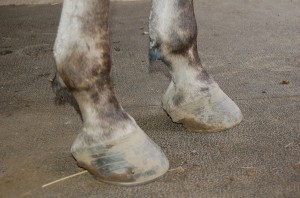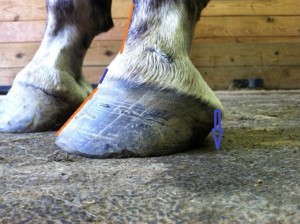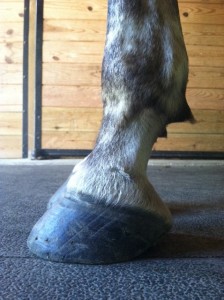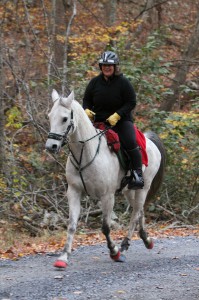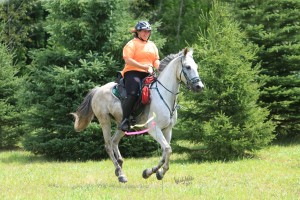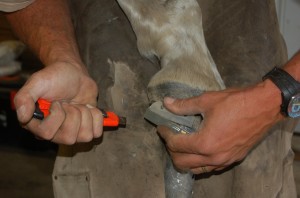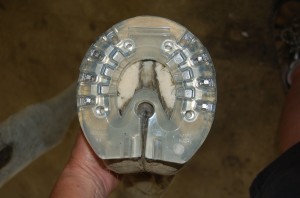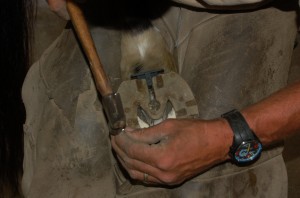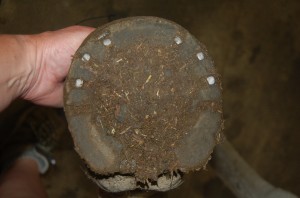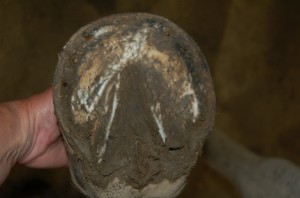To say that we have had some shoeing and booting challenges over the last year or two would be an epic understatement.
We’ve been at the endurance (and horse!) game long enough to know that the path to success is nowhere near linear.
If you add a few glued-on boots scattered along the edge of that path, or flung deep into the woods nearby, you’ll have a visual at to what we’ve experienced.
This horse, Ace, was the one who sent us on this journey.
This shot of Ace’s front feet from 2011 shows a multitude of issues. I hated that his toes got so long so fast. I hated that he, a short-backed, long strided creature, would interfere or forge or travels haunches-right or haunches-left to avoid hitting himself as his shoeing cycle went on. I hate that I was always trying to convince the farrier to “take a little more toe.”
Enough said.
I wasn’t confident enough in my eye to start making demands, or even any drastic changes.
The journey to where we are now has several bumps, tangents, much better but not quite good enough choices, wrong turns, paths that appeared to be a direct line from Point A to Point B and were ultimately a dead end. All with the best of intentions and not too many hurt feelings along the way. Such is life with horses.
In the end, there have been at least a dozen people who have helped to educate us and confirm our eye and how to fix what we see. I am not so naïve to think that we’ve reached a final destination, but if the horses are the judges (and they certainly are!), we are actually on the trail marked with ribbons for the loop we want to be riding!
Given Ace’s propensity to grow toe and his ongoing tendency to have a less than ideal palmar angle, he either needed to be trimmed with frequency that would be limited by steel shoes, or he needed to be barefoot and booted. And did I mention that we had some boot failures in the past?
What’s a negative palmar angle?
Image below from thehorse.com
Look a bit familiar from the photo of Ace above?
Yes, to me too.
Now, Ace’s feet weren’t quite that bad, but they indicated a less than ideal palmar angle.
EasyCare Inc.’s new EasyShoe Performance N/G (nail/glue) shoes sounded like they might be ideal. They could be nailed or glued since they had a nail plate, and the construction of the shoe would allow between-shoeing toe trims. They were due out in February and I was amped to try them.
From this (shoes pulled in October, 2012, four weeks after being shod and a week after the XP Bryce Canyon ride) — thanks Rusty! Right foot trimmed, left foot with just the shoes pulled.
To this, a year ago, where I could still see room for improvement in hoof balance:
Such that I was rasping a bit myself between trims from the trimmer, hoping that what I thought I saw was in fact what I was actually seeing:
To glue-on boots, which sometimes stayed on, but often came off. Three of these came off at Fort Valley — I was smart enough to purchase colors whose absence would be easy to spot. (Photo courtesy of Becky Pearman):
And all of these stayed on (photo courtesy of Wendy Webb) — I think it was the lovely Canadian air. We are both so happy that we are airborne:
Finally, I cried “Uncle” and had steel shoes nailed on for the final ride of the season in the New Jersey sand, which ended with a successful ride, but fill below Ace’s knee and a stress line from the coronary band which is still growing out.
We discovered Daisy Bicking’s Integrative Hoof Workshops, learned a great deal, and even hosted a clinic at our farm. We learned so much. And we were dying to try the EasyShoe Performance NGs!
Even then we had some struggles, gluing and nailing them, until Dave Augustine pulled us out of a lost-shoe situation, met us at a ride out of town and straight-nailed on the NG shoes.
We’ve not looked back.
The official videos for applying EasyShoes can be found at easycareinc.com but Dave has found a couple of twists on the nailing process that are working for us.
One is that rather than leaving the toe and quarter clips, he cuts these off, and then uses the “wings” to place the shoe on the foot, nails the front pair of nails, then cuts off the wings for ease of nailing the shoe toward the heels.
No glue, no product on the sole or in the collateral grooves.
Thus far, we’ve not needed to use the heel spacers for our horses, although Dave did use them to NARROW the heel opening on a shoe he reset on Wynne.
The beauty of these shoes is that they allow the heel to spread. Watching Sarge in front of me at Old Dominion 50, I could watch the shoe’s heels opening as his feet struck the ground and pushed off. Amazing!
Not a pretty photo, but these front shoes on Sarge show the wear from a 35 mile LD, a really rocky Old Dominion 50 and all of the conditioning between. Compare how far the heels have spread from the shoe in its original state:
In addition, the frog coverage means that it is very much like riding in a full pad. No ouchiness on rocks or gravel, and yet air can get in to the frog and the sole. Ace has a tendency toward central sulcus thrush — this is the healthiest we’ve ever seen his feet.
Then there is the advantage of absorbing concussion. When the horses trot down pavement in these shoes, rather than the clank, clank, clank of steel shoes hitting, you get the dulled thud that we did when the horses were booted. Concussion is the enemy with endurance horses, and these shoes really seem to be an ally against that foe.
The hoof growth during the shoeing period was remarkable. Lots of healthy wall growth. Zero thrush. Zero tenderness in the frog central sulcus.
As with all hoof boots and shoes, the shoe is only the icing on the cake. It is all about the trim!
Next stop, Master The Mountains 55 with Ace and Wynne, both in EasyShoe Performance NGs, and then, for Sarge, Vermont 100 with Richard.
We feel as though we are on very good footing!


